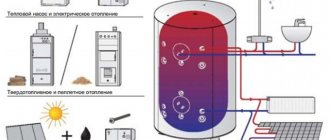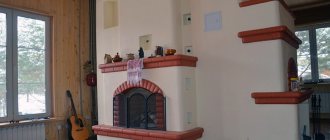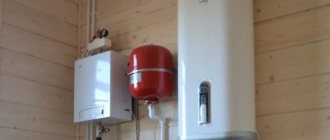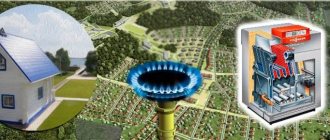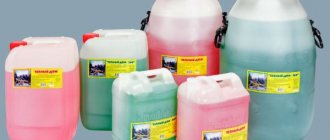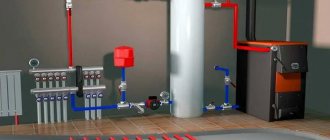Types of heaters
A home craftsman who wants to acquire a homemade “hot water bottle” can choose from several options:
It is a container equipped with a tubular electric heater (TEH) and filled with oil.
The main element of the heating element is a spiral made of nichrome or other material with high electrical resistance, which begins to heat up when an electric current is passed through it. The spiral is placed in a copper tube filled with sand.
The oil removes heat from the heating element, distributes it over the surface of the body and, in addition, serves as a heat accumulator (after a power outage, the device continues to heat the surrounding air for some time).
Steam-drip
In its design, a vapor-drip heater is very similar to an oil heater, only water vapor is used as a medium that distributes heat. It is formed from a small amount of water, which is poured into the body.
This solution provides two significant advantages:
- When freezing, the vapor-drip heater will not burst, since water occupies only a small part of its volume.
- Steam is an extremely capacious heat accumulator. More precisely, not so much steam as the evaporation process: it is during the transition from liquid to gaseous state that water accumulates a large amount of thermal energy, which is returned when steam condenses on the walls of the heater.
Having transferred heat to the body of the device, the condensed steam in the form of water flows to the lower part, where the heating element is installed. The power of the heating element and the volume of water are selected in such a way that rupture of the heater by steam pressure is excluded.
Due to the fact that the device body is hermetically sealed, its internal walls do not rust due to high humidity.
A candle flame is known to emit not only light, but also some heat.
Only it usually evaporates to the ceiling in the form of convective air currents and is “smeared” over the entire area of the room.
Why not place a heat trap above the candle? We will tell you what it is in the next section.
Infrared (IR)
Any substance with a temperature different from absolute zero emits “thermal” electromagnetic waves, which are called infrared.
The intensity of this radiation is directly dependent on the temperature of the substance. Water and oil radiators also emit IR waves, but in very small quantities because their surface is relatively cold.
To turn a metal object into an IR emitter, it is enough to heat it to a red glow temperature. If you use special materials, for example, graphite, then quite noticeable “heat” waves can be achieved at relatively low temperatures.
Knowledge of these subtleties will help us make our own IR heater, which will give us heat directly, that is, without the participation of air as an intermediary.
Other types
Since electricity is not available everywhere, structures running on gas or solid fuel have the right to life. The latter include potbelly stoves.
Heat pump
Operating principle of a heat pump
The heat pump consists of the following parts:
- Powerful compressor that creates high pressure.
- An evaporator-radiator consisting of thin tubes with high thermal conductivity.
During pump operation, the compressor influences the coolant. This substance can evaporate and boil even at the lowest temperature. The compressor creates pressure, causing the refrigerant to evaporate even at the lowest temperatures.
The coolant has a condenser in its path, in which the refrigerant transfers its heat to the radiator. It cools, turning into liquid, and then returns to the compressor. This type of cycle can have several repetitions.
The proportion of energy consumed by the compressor can be around 20%. The remaining 80% can be borrowed from the environment. A heat pump can take energy from the atmosphere or from geothermal sources. The peculiarity of modern units is that they are configured not only to heat, but also to cool the room.
Heating systems developed on the basis of heat pumps consist of the following parts:
- Probe (a piping system that is a large coil. It can be placed in water or soil. The task of the probe is to collect thermal energy).
- Heat pump (the principle of operation of such a mechanism is familiar to everyone. However, such pumps can be of several types: ground-water, water-air, water-water heat pump, air-air heat pump).
The advantages of the thermal mechanism can be described as high efficiency. Such a device can deliver from 4 to 5 kW of thermal energy. This ensures a comfortable temperature in the house.
Coal and wood stoves can be an excellent alternative to boilers, pumps and manifolds. Now you can buy them ready-made or build them yourself using the necessary materials.
Idea 1 Compact model for local heating
The simplest way to make an electric heater is this one. To get started, prepare the following materials:
- 2 identical rectangular glasses, each with an area of about 25 cm2 (for example, dimensions 4*6 cm);
- a piece of aluminum foil, the width of which is no greater than the width of the glass;
- cable for connecting an electric heater (copper, two-wire, with plug);
- paraffin candle;
- epoxy adhesive;
- sharp scissors;
- pliers;
- wooden block;
- sealant;
- several ear sticks;
- clean cloth.
As you can see, the materials for assembling a homemade electric heater are not at all scarce, and most importantly, everything can be at hand. So, you can make a small electric heater with your own hands using the following step-by-step instructions:
- Wipe the glass thoroughly with a cloth to remove dirt and dust.
- Using pliers, carefully grab the glass by the edge and burn one side with a candle. The soot should evenly cover the entire surface. Similarly, you need to burn one of the sides of the second glass. In order for carbon deposits to settle on the surface better, it is recommended to cool the glass before assembling the electric heater.
- After the glass pieces have cooled, carefully use ear sticks to clean the edges no more than 5 mm around the entire perimeter.
- Cut two strips of foil, the width exactly corresponding to the width of the smoked area on the glass.
- Apply glue to the glass over the entire burned surface (it is conductive).
- Place the pieces of foil as shown in the photo below. Then apply glue to the other half and connect them.
- Then seal all joints.
- Using a tester, measure the resistance of your homemade heater yourself. After this, calculate its power using the formula: P=I 2 *R. About how to use a multimeter. We talked about it in the corresponding article. If the power does not exceed the permissible values, proceed to complete the assembly. If the power is too high, you need to redo the heating element - make the carbon layer thicker (the resistance will become less).
- Glue the ends of the foil to one of the sides.
- Make a stand from a block, installing contact pads on it connected to an electrical cord.
Using this technology you can make an electric mini heater with your own hands. The maximum heating temperature will be about 40 o. which will be quite enough for local heating. However, such a homemade product will, of course, not be enough to heat a room, so below we will provide more efficient options for homemade electric heaters.
Heating in modern country houses
The principle of organizing a dacha heating system, thought out at the stage of designing a house, is no different from the heating systems of cottages and residential buildings. The decisive point is the presence of heating mains. But, as a rule, they are not. The second difference is the implementation of an economical, periodically used heating option, rather than a daily operating one.
To do this, any system must provide: rapid heating of the room of the required area, drainage of water from the pipeline during water heating and have high power for effective heating of houses with low thermal insulation properties.
The heating system in the country begins with the installation of the selected type of boiler and piping the house. It is better to entrust such necessary work as preparing the premises for the boiler room, organizing the devices necessary for ventilation of solid-state boilers, installing the pipeline, starting and testing to experienced specialists. The boiler can be electric, diesel, solid-state and gas.
There are hybrid boiler models that use solid fuel and electricity to operate. Their cost is much higher and they are not always profitable for a dacha where they do not live permanently in the winter. A wood-burning boiler is the easiest to withstand temperature changes in winter.
It also falls into the category of economical options. The convection type of wood boiler is the most common. It has a low noise level, which makes it possible to install it in basements. A large selection of modern boiler models makes it possible to increasingly use water heating.
When building a large dacha, it is the best heating option. Its essence lies in the possibility of constant circulation of water heated to the desired temperature through pipes to the batteries located in the house and back. To lay the pipeline, pipes made of metal, polypropylene or metal-plastic are most often used. They can be used for many decades only if properly preserved for the winter.
Another problem is the timely replacement of water filters, in the absence of which, the pipes quickly become clogged with various deposits of impurities contained in the water. Not only water, but also saline solution, glycerin, and propylene glycol can be used as a coolant.
Each of them has its own advantages and disadvantages. Glycerin, for example, does not harden and retains its fluid properties even at temperatures of 30° below zero, which prevents pipes from bursting. It's very expensive. Propylene glycol is not toxic, but its specific heat capacity is worse than the harmful ethylene glycol. In connection with the growing volume of construction of dachas from modern materials, it is most appropriate to involve experienced specialists in the implementation of your own heating system.
To keep your dacha warm in winter, you must choose one of the heating options. In this case, early insulation of the house is a very important point. Otherwise, efficiency sharply decreases and energy consumption increases. And it will be difficult to stay warm.
Practical recommendations for organizing heating in the video:
Why electricity
Electric heating differs from classic water-stove and gas systems by being more economical and practical. We will leave the first aspect for discussion below, and describe the operational advantages here:
Electric heating is not only silent, but also environmentally friendly. It is transported safer than gas and does not emit harmful substances at all, both into the atmosphere and indoors. In the absence of waste, the need for exhaust chimneys and traction structures disappears. Heating using coal or wood is not at all comparable to electric systems.
Heating with electricity does not require large one-time costs. You can make a comparison using gas as an example: to connect a house you must purchase equipment for each room, install communications, a boiler, and connect it to a common pipeline. Moreover, all this must be done together, since it is impossible to postpone connecting any part of the house to the system. And the electrical method allows you to organize sequential installation: first, the most important parts of the house are connected, and then, as funds accumulate, peripheral ones are connected.
Thanks to the possibility of using a multi-tariff meter in a private house or apartment, as well as the constant development of technology in this area, electric heating is already the most economical among analogues
You should not focus on the high price of the equipment - it quickly pays for itself due to low energy consumption. Almost every method of organizing electric heating allows you to install it yourself, without many additional tools.
The use of electrical systems for heating cannot be called ideal. The work of high-quality heating of each home requires taking into account many features. In some regions, the cost of electricity can be so high that gas cannot be avoided. In old apartment buildings, it is difficult to switch to electric heating for two reasons: it is very difficult to disconnect from the central highway, and the electrical network will have to be reconnected, taking into account powerful equipment.
Despite this, the overall picture tips the scales towards electricity. For premises where there is no gas or where there is no possibility of supplying it, it is a real salvation.
Pocket warmers for smartphones
A budget option for reusable heating devices for those who do not need long-term heat. Inside these small inserts there is a gel, which, after activation, can give off heat for about 20 minutes. However, after each use it will have to be kept in boiling water for 5 minutes - which is not very convenient. But these stylish liners can warm not only your hands. Users share their life hacks: in severe frost, they put them in their pocket with their smartphone - and the battery does not die from the low temperature. Some of the models can also, if necessary, be used as “coolers” in the heat - after cooling in the refrigerator, The most popular models of gel heating pads: For Pro Hand and Body Warmers, Hotsy!
and
Hand Warmers - HotSnapZ Reusable Round & Pocket Warmers.
Heat pumps
A heat pump is a device that is capable of receiving energy for heat supply from any source: earth, water, air.
The operating principle of a heat pump is based on the Carnot heat exchange cycle (the same one used by a refrigerator).
The heat pump device includes two main elements - a condenser and an evaporator, connected into a common circuit.
The coolant circulates in the circuit under the influence of the compressor.
To effectively use low-temperature sources such as groundwater (read a description of the aquifers of river floodplains here), it has a low boiling point.
Furnace heating system
This type of heating is not particularly popular today, due to some of its features. However, many owners still prefer to heat their dacha in winter using a traditional stove, so this method should be described in more detail, as heating a dacha house is not so easy.
The main disadvantage of this option for heating a private home is the difficulty of servicing the stove. So, for high-quality heating, the system should be ignited several times a day, adding new portions of fuel. If the ignition material is coal, then in this case the resulting ash should also be regularly removed, which also requires a certain amount of time.
The main advantage of the furnace system is absolute autonomy. Heating a country house in winter using a stove does not require the use of either electricity or gas (for more details: “How to heat a house if there is no gas”). The main fuel is only wood and coal. The elementary nature of the design completely eliminates the risk of breakdown. There are two main types of stoves:
- traditional Russian stove;
- heating system for a summer house. called a potbelly stove.
The massive mechanism of the Russian stove can perform several useful functions at once. It is perfect for cooking, the warm surface allows you to sleep on such a stove, and, of course, such a unit is capable of heating a private house
It is important to note that due to its large size, heating can be provided to several living spaces at once, and the fact that a traditional Russian stove is made of brick ensures long-term heat retention and prevents any temperature changes
The disadvantages of such a stove include its massiveness. To equip such a heating device, you will need to allocate from 6 to 8 m² in the room. In addition, the time for heating such a furnace is long (bricks need at least several hours to warm up). It is impossible not to mention the fact that it is worth installing a Russian stove only in one-story buildings, since otherwise the structure will no longer resemble a stove and will look like real industrial equipment, distinguished by its enormous size.
Heating a dacha in winter using a potbelly stove differs from heating it with a stove. This equipment takes up very little space (about 1 m²). Warm-up time is very fast and little fuel is required. In addition, if desired, you can cook food on the surface of the potbelly stove or, for example, boil a kettle.
However, these products also have disadvantages. The potbelly stove cools down as quickly as it warms up, so in order to avoid frequent temperature changes in the room, fuel will have to be added very often, which is especially inconvenient at night. Moreover, only one room can be provided with heat from a potbelly stove, since such equipment does not have enough power to heat more rooms, so it is better to avoid using a potbelly stove in a large house.
Metal furnaces
Once upon a time they were called potbelly stoves. This name dates back to the distant times of the civil war and subsequent devastation, when the simplest joys of life were associated with great wealth.
Much has changed since then, but an iron stove is still called a potbelly stove. They look different now. Many of them are equipped with fireproof glass windows, but their essence has not changed - they heat up quickly and cool down just as quickly.
Maybe that’s why this stove was called a potbelly stove, because maintaining a constantly high temperature requires a lot of wood, bourgeois style.
Folk fantasy
In the Siberian taiga huts, where it is possible to install a cast-iron stove, but it is difficult to deliver bricks, the potbelly stove is lined on three sides with large stones, rolled in by the river. It turns out beautiful and functional - the stones heat up and slowly release heat to the air.
This technique is quite applicable in the conditions of a country house - when the house is built, but the heating is not yet ready. To some extent, stones perform fire-fighting functions, absorbing random sparks and excess heat. Stone structures can serve as a reason for the designer’s flights of fancy.
The efficiency of a metal stove will increase if you equip it with a coil for heating water and connect heating batteries to it.
Electric water heating system
A hydronic system is an effective heating option.
This option is preferable to using liquid fuel boilers. First of all, because of the power of the equipment and the ability to heat all rooms. Before you start equipping your home with such a system, you need to make accurate calculations.
First you need to select a boiler and determine the location of the batteries. To do this, be sure to take into account the area of the heated premises, the insulation material on the walls (if any) and the heat losses of the house in the winter season. It would be good if the building is connected to the water supply system, but practice shows that often this possibility is not available. After this, you need to draw up a plan for the movement of water through the pipes.
The advantages of this method include:
- work autonomy;
- safety and environmental friendliness;
- no need for expensive maintenance and repairs.
Option 5: Heat pumps
How does a heat pump work?
Essentially the same as a regular refrigerator.
Here is its working cycle:
- The compressor compresses the refrigerant gas;
- Under pressure, it turns into a liquid state, while noticeably heating up;
- Passing the heat exchanger, freon gives off excess heat;
- Then it passes through the expansion valve and, with a sharp drop in pressure, goes into a gaseous state of aggregation. In full accordance with the laws of physics, during a phase transition its temperature drops by several tens of degrees;
- In the second heat exchanger, cold freon takes away excess heat from the external environment. Yes, it has a low temperature, but the refrigerant is even colder!
- Then it goes to the compressor, where it is compressed - and so on ad infinitum.
Heat pump operating cycle.
What is the beauty of using such a scheme?
- Energy is spent only on the operation of the compressor, and not on heating the coolant. As a result, for every kilowatt-hour of electricity spent, 3-6 kilowatt-hours of heat are pumped into the house;
- The requirements for allocated electrical power are also falling proportionally. Let's say, with a limit of 2.5 kilowatts, you can provide a thermal power of 7.5 - 15 kW, which is quite enough to heat a house with an area of one hundred square meters.
The lower the coolant temperature, the cheaper the heating.
Expenses
The price of a kilowatt-hour of heat obtained by operating a heat pump ranges from 0.6 to 1.3 rubles. Obviously, this heating without gas is one of the most economical.
The flip side of low operating costs is the high cost of the corresponding equipment and its installation. Let’s say, for a pump with a thermal power of 16 kW, operating according to the “ground-water” scheme, you will have to pay about 600,000 rubles. Its installation and setup will cost at least another half of this amount.
Different methods of installing ground heat exchangers vary in cost. Drilling a well for a vertical heat exchanger will cost more, laying the collector in a trench below the freezing level is cheaper.
Horizontal (left) and vertical (right) ground collectors.
However, a horizontal collector requires a free area three times larger than the heated area of the house.
Installation of a horizontal collector. Estimate the area of the site involved.
In warm regions, you can significantly save money by using the cheapest type of heat pumps that operate on an air-to-air basis (simply put, inverter air conditioners).
One air conditioner with a thermal power of about 4 kW (12,000 BTU) will cost the buyer about 30,000 rubles, its installation will cost another 5,000. The cost of an air heating system with a power of 16 kW will be 35 * 4 = 140 thousand rubles.
I have exactly this heating scheme implemented at home. Two floors with a total area of 150 m2 are heated by four inverters. Average electricity consumption in the winter months is 1500 kWh/month; heating continues to perform its functions even in severe frosts, at -15 - -20 degrees, rare in Crimea.
The photo shows one of the air conditioners that heats the house.
In case of more severe frosts, the house has a backup water heating system with a heating element electric boiler.
The electric boiler can be used if the outside temperature drops below -25 degrees.
Convenience
All types of heat pumps are completely autonomous, do not require maintenance and are capable of regulating heat transfer in a fully automatic mode, based on the readings of remote temperature sensors.
Many models allow programming of daily and weekly operating cycles: for example, at night the room temperature can decrease, and on weekends it can rise by 2-3 degrees.
Household air conditioners are somewhat more primitive: you can only program the on and off times in a daily cycle.
https://youtube.com/watch?v=LHsiSeLNFgo
Water heating system for a dacha
Another option for heating a dacha in winter is to use heating boilers. Despite some complexity of their installation, the result will be definitely positive.
Based on what fuel is used, boilers are usually divided into the following types:
- diesel systems;
- gas boilers;
- boilers running on solid fuel.
One of the most common boiler systems are devices that run on diesel fuel. However, such equipment can hardly be called innovative, since today the price of diesel fuel is very high, so not everyone can afford to install such a unit.
However, these products have no other serious drawbacks, with the exception of the emission of unpleasant smoke during operation. To get rid of burning, the chimney of such a boiler should be mounted on the surface.
Among the advantages of these mechanisms are the possibility of storage in a large tank, high energy intensity, as well as autonomous operation, which eliminates the participation of owners in the operation of the device.
Gas boiler systems are becoming increasingly common. All that is required for their installation is the presence of a stable gas supply point. Gas has more advantages over diesel fuel. This natural fuel costs much less, in addition, during its combustion no harmful substances or acrid smoke are produced, and there is no need to store such fuel in large volumes.
The main disadvantage of these boilers is the risk of fire. Even a small gas leak can cause very serious and unpleasant consequences. It is this drawback that scares off many consumers, although in fact the danger of explosion in modern devices is practically reduced to zero.
To completely eliminate the risk of fire, experts recommend installing this room not under the house, but in a separate room. In addition, before starting installation, the right decision would be to study various photos of gas structures and detailed videos on their installation.
An example of self-implementation of heating a summer house in winter:
Another type of boiler is solid fuel. They are used less frequently than the systems described above, in particular, due to potential problems during their operation. Fueling must be done manually, which is not always convenient.
Among the advantages of solid fuel boilers is the low cost of consumables, such as wood, peat, coal, and the fuel itself can be stored anywhere
It is only important to provide it with protection from getting wet.
Biofuel use
Biological fuel is any organic matter that can burn. However, this term has recently come to mean the use of gases released by rotting organic matter.
Principle of operation
Anything that rots with sufficient intensity is suitable as a source of such gas. Typically, manure, food waste, and plant matter are used. All gases formed during the decay process burn well and replace natural gas.
The biofuel heating installation itself consists of units that collect the emitted gas, purify it and feed it into boilers for combustion. And then the operating principle is the same as that of a natural gas boiler.
Minuses
A significant disadvantage of this heating method is the low rotting performance under natural conditions. In order to speed up this process, you need to increase the temperature, which costs energy.
For this reason, it is impossible to use biofuel as the main method of heating a large house, but heating a small house or creating an auxiliary system is quite possible.
Biofuel heating is widely used by farms in countries such as Greece, Spain, and Portugal.
Types of heating systems for country houses
The types of heating systems may depend on the available energy resource, design features, climatic conditions, and the budget of the dacha owner.
The main types of space heating are:
- gas heaters;
- electric heaters;
- furnace equipment;
- equipment operating on liquid fuel resources;
- equipment operating on solid fuel resources;
- universal heating systems.
Choosing each type of heating requires drawing up a cost budget, taking into account the area of the building that needs heating. The choice of heat supply method will determine how to maintain a positive temperature when you are away from your summer cottage.
Comparative analysis based on other criteria
In addition to the questions: the cheaper it is to heat a house, fuel consumption and efficiency, various heat generation options can be compared according to other parameters:
- From an environmental point of view, it is better to use equipment that runs on electricity. Then there is a gas boiler and combined gas-electricity systems.
- Electric convectors and infrared emitters have advantages in terms of complexity and cost of maintenance. The most demanding in terms of this parameter will be solid fuel systems, which require daily cleaning and loading.
- In terms of installation complexity, hybrid systems rank first, for example, solar collectors - gas boiler. The easiest to install is electrical equipment, followed by solid fuel boilers. Gas devices are installed, tested, and serviced only by special organizations and require a large number of permits.
- According to safety criteria, any heating system can lead to unpleasant consequences if used incorrectly. Possible electric shocks, fires, and gas explosions.
Nuances of operation
Heating systems have their own operating characteristics depending on the quality of installation and type of equipment.
Systems of the same type work differently because:
- fuel of a different quality is used;
- coolant parameters differ;
- a local zone of low pressure has formed in the expansion tank;
- air is sucked into the circuit due to a leak;
- air diffusion occurs through the surface of pipes made of plastic;
- During the installation of the pipeline, plugs were allowed to form, for example, when soldering pipes.
About fuel storage
To prepare a supply of firewood for the entire season, you will need a room protected from moisture. Coal, briquettes and pellets also require special storage conditions.
To contain liquid fuels, you will need a plastic or metal container, which should not be in the basement.
Equipment service
Primary and additional heating in a cottage or private house require periodic inspection, repair and replacement of components. The following signs indicate the need for work:
- Coolant is leaking from radiators and pipes;
- seething or noise is heard in the system;
- uneven heating in different rooms and floors;
- The system functions worse than at startup.
Possible causes of problems:
- design errors;
- the tightness of the connections is broken;
- Radiators are installed incorrectly;
- air pockets interfere with coolant circulation;
- equipment was installed in bad faith;
- due to incorrect connections, the system was unbalanced;
- use of low-quality components.
Heating a dacha without gas, water heating system with diesel
Diesel boilers can become a replacement for gas heating.
Diesel boilers are quite popular. running on diesel or diesel fuel. On sale you can find equipment using kerosene, rapeseed oil and other liquids. The advantages of using such boilers include:
- high level of efficiency (at least 92%);
- no need to obtain permits and approvals for the installation of such a boiler.
Before purchasing, be sure to know about the disadvantages:
- high level of fire hazard;
- such a boiler is not considered environmentally friendly;
- fuel for the boiler is difficult to store - for example, for diesel fuel you need to allocate a separate room, preferably not adjacent to a residential building;
- The cost of fuel is not cheap.
Solar collectors
An excellent alternative to gas heating is solar collectors. Such installations operate smoothly and economically. Collectors are ways to maintain heat in a room for a long time. But the main thing is that under good conditions they can generate electricity. Such installations have both their advantages and disadvantages.
Thus, solar collectors are absolutely safe. Installing such installations is quite simple and quick. Collectors are installed somewhere on the façade of a building. The installation will fit perfectly into the design of the house, since among a wide range you can choose the most suitable option for yourself. But most importantly, collectors provide significant savings in utility costs. Therefore, this type of installation is perfect even for low-income families.
The only drawback of such collectors is that they operate exclusively on solar energy. This determines the specifics of the installation of collectors. In regions where it is sunny almost all year round (usually the south of the country), installing collectors is completely justified. But in northern latitudes these installations will be completely useless.
Heater, camping stove for heating food from cans, alcohol lamp
The design is known abroad as an alcohol stove, or in Russian - an alcohol lamp. The Swedish army has even adopted it.
Alcohol is used because it does not smoke when burned. This means the dishes remain clean and no soot or smoke floats in the air. The design is as simple as 3 kopecks and can be repeated in a few minutes from any available materials. For example, a beer can, coffee can or condensed milk can be used as a donor for the stove.
More specifically: you need a small iron container with an iron lid, or you will have to cover it with something.
The author used a can of Korenovsky condensed milk - it is convenient because there is an almost airtight lid on top, but even without it everything will work if there is a flat-bottomed dish on top.
So: we take a jar, a ruler, a strip of checkered leaves and a marker or any drawing or scratching object.
1. Mark a stripe on the can, moving one third from the top. The easiest way to do this is by spinning the jar while holding the marker in one position.
2. We wrap a strip of paper around the edge of the mark and fasten it with a piece of tape or glue.
3. We begin to drill, pierce with an awl or cut holes with a knife along the marked strip. In this case, I made a series of holes with a diameter of 0.8 mm through 10 mm and through 5 mm - which option is better for you - decide for yourself. You can see how they burn below. A small hole diameter for proper combustion is better than a large one, but you can make 3-5 holes a centimeter each. The uniformity of the holes is a purely aesthetic point in order to get a beautiful crown of flame like from a regular gas stove. All!
Well, not quite of course, now we’re learning how to light it up. You need to add alcohol and close the lid, 50 ml burns for 15 minutes or more. Place on a non-flammable surface and shake lightly so that the alcohol flows a little onto the outside of the jar through the holes. We light the alcohol outside and wait until it burns out. We repeat the procedure until we get a self-sustaining flame from improvised nozzles around the can. Usually it is enough to repeat 2-3 times and everything starts working on its own.
Its operating principle is simple: the flame heats the walls of the jar, the heat is transferred down the walls to the alcohol, the alcohol boils near the walls and the pressure inside increases, the alcohol vapor comes out under pressure through the holes and mixes with air and burns beautifully. Now we put a pot, a kettle, a mug on top, or we just warm ourselves around the stove - it gives a lot of heat and burns for a long time.
For greater heat transfer, you can place a homemade alcohol lamp in a larger iron container, which would heat up and release heat:
The smaller the number of holes, the harder it is to light, but the less fuel consumption and less heat from it. A liter of water boils in less than 10 minutes. It is resistant to wind, extinguish by covering, add as much fuel as needed, otherwise you will have to wait for it to burn out or pour the hot alcohol back into the container, which is not safe.
Similar options “for one mug” from a tin can with a filler hole that is closed with a coin and from an aerosol can:
Choice of energy carrier
There is an inverse relationship between the efficiency of heating and the cost of equipment: the more expensive it is to purchase, the cheaper it will be to operate.
What is the most economical heating in a private house? There is no universal answer to this question.
In forests, the cheapest fuel may be firewood; in areas of coal or peat mining, coal or peat, respectively.
In some places it is possible to connect gas, but in others it is not. The most economical electric heating is expensive in any case, but there are options to choose from. To heat houses the following are used:
- gas boilers and convectors;
- solid fuel - firewood, pellets, coal, peat, briquettes, wood and crop waste;
- liquid fuel;
- electric boilers. other electrical appliances;
- heat pumps. We will not consider this option: installation of the system is very expensive, it pays off in 10 years;
- solar panels and collectors. The installation is not justified: batteries collect little energy on winter and cloudy days.
Purchasing a diesel boiler is justified when the household is large (for example, a farm) and the owners have access to cheap fuel. Diesel boilers are produced only with high power; these are not required for a medium-sized house.
But the equipment has many disadvantages: environmental damage, noisy operation, large dimensions and weight, fire hazard. The compact modification of the liquid fuel unit - the exhaust boiler - is also environmentally harmful and fire hazardous. It is low-power, but it is not installed in the house, only in utility buildings.
Another option on how to save on heating a private home: purchase a combined/universal boiler for two or more types of fuel. When purchased, it will cost more than any other.
But, firstly, under no circumstances will you be left without heating: in the absence of one energy source, you will switch to another. Secondly, there is room for savings. For example, expensive electricity can be burned only at “cheap” night time (with two-tariff payment), and during the day it can be heated with wood or coal.
Pellets are economical home heating without gas and pipes
Pellet boilers are a modern alternative to gas.
Pellets are considered an alternative energy source. They are made from wood waste (shavings, sawdust) or from agricultural waste.
It is worth noting that many Europeans, trying to find options on how to heat a country house without gas, choose pellet boilers. assessing the cost-effectiveness of their use.
The advantages of using pellets include:
- environmental safety (one granule contains a maximum of 3% ash);
- maximum safety of use, since this fuel is not subject to spontaneous combustion;
- pellet boilers have a high level of efficiency;
- low cost of “fuel”, which ensures energy-saving heating without gas.
Now you know how to heat a dacha without gas. As you can see, there are a lot of different options, and therefore, to choose, you need to focus on your financial capabilities and needs.
Interesting on the topic:
- Heat meters: how to install
- Features of installation of circulation pumps for.
- What is AOGV, types and installation
- Bear boilers: overview of the model range and characteristics.
Convectors and warm baseboards
The convector is also not the cheapest model, since everything depends on electricity, and energy prices are quite high.
Recently, the warm baseboard system has proven itself well, replacing stationary radiators; it works on the principle of heating a coolant liquid, which creates a heat shield around the perimeter of all rooms. This is practically the most economical home heating, which also has a beneficial effect on health, prevents the appearance of dampness and condensation, and also saves heating.
How to heat a dacha in winter - practical recommendations
At this time of year there is no tedious weeding, planting, watering and other time-consuming work, but very interesting for people of any age. There is time to just walk around the snow-covered garden, dream and plan the beds for future planting. Clear the snow from the paths, and then warm up and drink fragrant tea infused with herbs in your home. The main thing is that there is warmth in it, which can be created, but is not always easy.
Modern technologies mastered in the production of building materials make it possible to choose any of them and even build a multi-story dacha in a short time. And immediately with a well-thought-out heating system, designed and implemented not only independently, but also with the involvement of specialists in this field.
Method 1 electric convectors
With the help of electric convectors it is possible to provide a cheap and efficient heating system. The electric convector is built on the principle of natural air circulation. Warm air moves upward from the heater, thus stimulating the movement of air inside the room and ensuring uniform heating. However, a convector is effective only in warm climates, when the temperature does not fall below 10-15 degrees.
pros
- No forced air blowing. Even in the cleanest home there are particulates that lie on surfaces. When warm air is artificially blown out of a heater, this dust becomes part of the air we breathe. Natural air circulation is not so active, so dust does not rise into the air.
- Small size with sufficient power. The heating elements of convectors heat up quickly, converting electricity into heat with an efficiency of up to 80%. In addition, there is a system of operation in different modes, as well as thermostats that allow operation not constantly, but only when the air temperature drops.
- Mobility, allowing you to move the convector around the room, to places with maximum cold flow.
- The possibility of creating a heating system exclusively using convectors or using them as part of a more complex heating system.
- The electric heating element does not heat up more than 100 degrees, and the body - 60 degrees. They have an increased level of protection from moisture, which allows the convector to be used in the kitchen and bathrooms.
Solid fuel boilers
To heat a house without gas or electricity, you should think about the energy of burning solid fuels:
- brick kilns;
- metal furnaces;
- solid fuel boilers.
There are also fireplaces, but it is difficult to classify them as a home heating system, since they can only be used to heat one room.
Boiler operating conditions
The main models of solid fuel boilers are designed in such a way that the air flow that ensures combustion is directed by a mechanical thermostat with a chain drive. In this case, natural draft of the chimney must be ensured. However, for normal operation of the boiler, a number of conditions must be met:
- Place the pipe so that it is no higher than the incoming pipe.
- Provide the system with free communication with the external environment using an open expansion tank located at the top.
- Create a pipe system with optimal diameters and a minimum number of dead-end branches.
- Equip the boiler with fire safety equipment.
The cost of solid fuel boilers varies in a very wide range - from 20 to 300-400 thousand rubles. It all depends on the design and capacity.
However, despite the price, solid fuel boilers are the best sellers among home heating equipment without gas or electricity.
